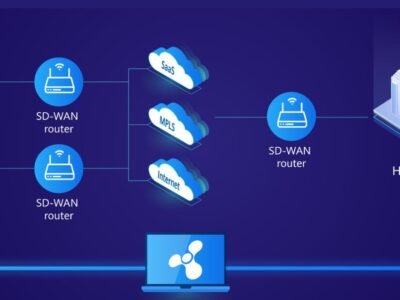Introduction
The digital transformation landscape is profoundly reshaping how businesses operate, and the integration of SD-WAN implementation has become a cornerstone for modern enterprises. The increasing reliance of companies on cloud services and remote work setups highlights the necessity for a strong, secure, and effective network management system. Organizations seek new ways to manage their networks effectively while ensuring top-notch security.
This shift towards more sophisticated networking solutions is crucial for staying competitive and thriving in today’s fast-paced digital environment. The push for advanced networking is driven by the need to support various digital applications, maintain uptime, and enhance user experiences.
What is SD-WAN?
Software-Defined Wide Area Network is a virtualized solution that links and expands corporate networks over vast distances. Unlike traditional WAN architectures that rely heavily on physical hardware and often result in suboptimal performance, SD-WAN leverages software to control network traffic.
It makes it more flexible and cost-effective. By utilizing intelligent traffic management and dynamic path selection, SD-WAN can deliver high-quality connectivity even over less reliable internet connections, making it a game-changer for businesses with distributed operations.
The technology allows organizations to consolidate multiple network functions into a single interface, simplifying network management and lowering operational costs.
Benefits of Secure SD-WAN
Secure SD-WAN offers numerous advantages, including enhanced security, optimized performance, and simplified management. By integrating security features such as encryption, firewalls, and intrusion detection directly into the network infrastructure, organizations can protect sensitive data while ensuring high-speed connections.
Additionally, SD-WAN can help reduce operational costs by minimizing the need for expensive MPLS circuits and reducing dependency on traditional network hardware. This cost-efficiency and improved network performance position Secure SD-WAN as a vital asset for companies looking to modernize their IT infrastructure. Furthermore, the ability to optimize traffic for specific applications ensures that critical business operations are always prioritized and remain unaffected by less important data traffic.
Critical Components of a Secure SD-WAN
Understanding the core components of a Secure SD-WAN can help organizations effectively deploy and manage their network environments. These components include:
- Centralized Management: A centralized control plane allows network administrators to streamline the oversight and control of network traffic, simplifying configuration, monitoring, and troubleshooting. It also simplifies the management of numerous devices and networks, enhancing operational effectiveness.
- Integrated Security: Security measures like firewalls, encryption, and intrusion detection systems are integrated into the SD-WAN software, delivering multiple levels of defense for data and applications. These security measures ensure that traffic is inspected and secured at each network node, reducing the risk of data breaches.
- Application Optimization: SD-WAN ensures critical applications receive the necessary bandwidth and priority through intelligent traffic routing and path optimization, enhancing user experience and productivity. SD-WAN can dynamically adjust traffic flows by analyzing real-time network conditions to maintain application performance and reliability.
Real-World Applications
Secure SD-WAN solutions are being implemented across various sectors, from retail to healthcare. For instance, healthcare providers utilize SD-WAN to manage large volumes of patient data securely and efficiently, ensuring compliance with regulations such as HIPAA.
Retail businesses use SD-WAN to connect multiple store locations, enabling real-time inventory management and enhancing customer experiences. SD-WAN’s ability to scale and be flexible makes it a perfect choice for businesses of varying sizes, allowing them to adjust quickly to evolving business requirements.
Businesses adopting SD-WAN solutions can reduce operational costs by up to 50%, highlighting its financial benefits. Moreover, SD-WAN is utilized in manufacturing, finance, and education sectors to streamline network complexities and provide secure, high-performance connectivity.
Comparisons with Traditional Networks
Conventional WANs need costly hardware and labor-heavy administration, posing a significant challenge for companies seeking to expand. In contrast, SD-WAN offers a more flexible and cost-effective solution.
With SD-WAN, companies can leverage existing internet connections to create a more dynamic and resilient network. This adaptability enables faster implementation and simpler administration. Additionally, SD-WAN can improve network reliability by using multiple connections, such as broadband and LTE, providing automatic failover capabilities during outages. Businesses utilizing SD-WAN can gain a competitive edge by modernizing their network infrastructure without the high costs associated with traditional WAN setups.
Challenges and Solutions
While Secure SD-WAN offers many benefits, its deployment is challenging. Common issues include:
- Compatibility: Ensuring the SD-WAN solution integrates seamlessly with existing IT infrastructure can be complex, especially in diverse and aging network environments. Implementing SD-WAN necessitates thoroughly assessing existing IT assets to ensure compatibility and performance optimization.
- Management Complexity: Despite centralized management, the initial configuration and ongoing adjustments can only be challenging with the proper expertise and tools. Additionally, continuous monitoring, updating, and fine-tuning of network settings requires skilled professionals well-versed in SD-WAN technologies.
Working with experienced SD-WAN service providers can also help mitigate these challenges by providing tailored deployment and support strategies.
Furthermore, leveraging managed SD-WAN services can alleviate the burden on in-house IT teams, allowing them to focus on core business initiatives. In contrast, the service provider handles the complexities of network management.
Future Trends
The future of Secure SD-WAN looks promising, with advancements aimed at improving AI integration, automation, and security. Anticipated improvements in SD-WAN capabilities through emerging technologies will bring incredible innovation and network adaptability.
These technologies can automate network optimization procedures, forecast potential problems in advance, and suggest ways to enhance performance. As enterprises continue to adopt cloud-first strategies and embrace remote work, the role of Secure SD-WAN will undoubtedly become more critical.
This evolution will likely lead to more streamlined and secure network management, further solidifying SD-WAN’s place as a cornerstone of modern enterprise IT infrastructure.
The increased focus on generating real-time network insights and enhancing user experience will drive continued innovation in the SD-WAN space.
If you found our content helpful don’t forget to share it on your social media: Twitter.
For more insightful articles, please visit globalexpressinfo.com







